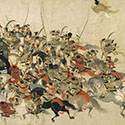|
|
| Show All 11 Results (Text Only) |
|
| The Art of Calligraphy in Asia |
|
|
“Calligraphy, the art of beautiful writing, was long considered the supreme art form in China, Japan, and Korea. This elevated status reflects the importance of the written word in East Asian cultures. In ancient China, early emperors asserted their power by engraving edicts or pronouncements on stone in their own calligraphic script. The elite members of society were scholar ¬officials, whose status was attained by their command of the written word. In addition to the central role played by writing in Chinese culture, the visual form of the language also contributed to the distinctiveness of the calligraphic tradition. The vast number and complexity of the characters that make up the Chinese script presented artists with a unique platform on which to explore the creative possibilities of design. The writing of Chinese characters-which was then widely adopted in Korea around the fourth century and in Japan in the mid-sixth century-was thought to be the purest visual manifestation of the writer's inner character and level of cultivation. It was the medium through which a person's thoughts, feelings, and artistry were best conveyed. In looking at a piece of calligraphy, we may admire the way a calligrapher manipulated the brush to create an object of beauty in which rhythmic energy is conveyed through strokes and dots done with ink. Changes in ink gradation, the relationship between characters, and the elegance of a single line can entice viewers regardless of the legibility of the text.
Go to Museum Resource: https://artmuseum.princeton.edu/object-package/art-calligraphy-asia/104193 | |
|
|
| Chinese Landscape Painting During the Song Dynasty |
|
|
“Landscape painting dominated Chinese painting beginning in the tenth century. The word for landscape painting in Chinese, shan shui hua, literally means “mountain (shan) water (shui) painting (hua).” Mountains are hard and unyielding; water is soft and fluid. These opposites are an example of the concept of yin and yang—the idea that everything in nature is composed of complementary but opposing forces that interact and change. Complementary opposites is one of several core cultural concepts of the Song dynasty that are encapsulated in many of the period’s landscape paintings.”
Go to Museum Resource: https://artmuseum.princeton.edu/asian-art/china/resources/landscape-painting/ | |
|
|
|
| Explore a Japanese Handscroll: The Art of Hon'ami Kōetsu (Edo Period, early 1600s) |
|
|
An excellent interactive website for exploring an Edo period handscroll by Hon'ami Kōetsu (1558-1637). "In this handscroll Kōetsu transcribed ten verses from the poetry anthology Shinkokin wakashū on sheets of colored paper that are decorated on the front and back with woodblock-printed mica designs." After exploring the scroll the user can write his/her own poem (by selecting from a set of phrases) and then see this poem "written" on his/her own handscroll in the style of Kōetsu.
Go to Museum Resource: https://artmuseum.princeton.edu/asian-art/japan/viewers/poem-scroll-viewer/ | |
|
|
| Heiji Monogatari Emaki (Tale of the Heiji Rebellion) Scrolls with A Night Attack on the Sanjo Palace |
|
|
The Heiji disturbance, which occurred late in 1159, represents a brief armed skirmish in the capital. ...The Heiji scrolls date from the thirteenth century and represent a masterpiece of "Yamato" style painting. The scene appearing here, entitled "A Night Attack on the Sanjo Palace," is the property of the Boston Museum of Fine Arts, provides an excellent introduction to the genre of picture scrolls. The scrolls read from right to left, and all action flows to the left. They can be documented as being treasured artifacts in the fifteenth century, when nobles mention viewing them, but they now only survive in fragmentary form.
Go to Museum Resource: http://digital.princeton.edu/heijiscroll/ | |
|
|
|
|
| Recarving China's Past: Art, Archeology, and Architecture of the Wu Family Shrines |
|
|
Interactive virtual reality tour, "Explore the Wu Family Shrines"; two pdf files: "Exhibition Handout," "Recarving China's Past"; "Map of Shandong Region Han Dynasty Archaeology Sites" with labels for the Wu Family Shrine and many other archaeological sites. “An interactive model of the Wu Family Shrine – created using 3D modeling software and GPS readings – allows you to explore the foundations of one of ancient China’s richest cultural eras.”
Go to Museum Resource: https://artmuseum.princeton.edu/legacy-projects/WuShrines/interactive.htm | |
|
|
|
| Show All 11 Results (Text Only) |








